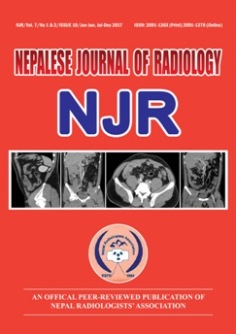Ultrasonographic Measurement of Placental Thickness During Pregnancy as a Parameter For Estimating Gestational Age of The Foetus
DOI:
https://doi.org/10.3126/njr.v7i1-2.19349Keywords:
Gestational age, Placental thickness, UltrasonographyAbstract
Introduction: Routine ultrasonography in pregnancy has the role in identifying the position, parenchyma echo pattern, variability of thickness of placenta which is associated with increased perinatal risk to both the foetus and mother. This study was carried out to establish the value of placental thickness measurement during normal pregnancy as a reliable parameter for estimating gestational age of the foetus.
Methods: This was a prospective cross-sectional study done in the Department of Radiology and Imaging at Tribhuvan University Teaching Hospital from September 2004 to April 2005. Total 350 normal pregnant women of more than 15 weeks of gestation were included. Ultrasonographic measurement of placental thickness and fetal biometric measurements were obtained. Correlation coefficient tests were performed between the gestational age in weeks and placental thickness using Karl Pearson formula in SPSS 10 package.
Results: Mean placental thickness measured at the cord insertion site increased from 15.28 mm at 15 weeks of gestational age to 39.57 mm at 39 weeks of gestational age correlated almost exact with a standard mean of deviation of ± 1.8 mm (r >0.851, p <0.001).
Conclusion: Ultrasonographic measurement of placental thickness during normal pregnancy can predict the gestational age of the fetus with high confidence level and can be included as one of the biometric measurements of foetus to estimate its gestational age.
Downloads
Downloads
Published
How to Cite
Issue
Section
License
This license enables reusers to distribute, remix, adapt, and build upon the material in any medium or format, so long as attribution is given to the creator. The license allows for commercial use.




